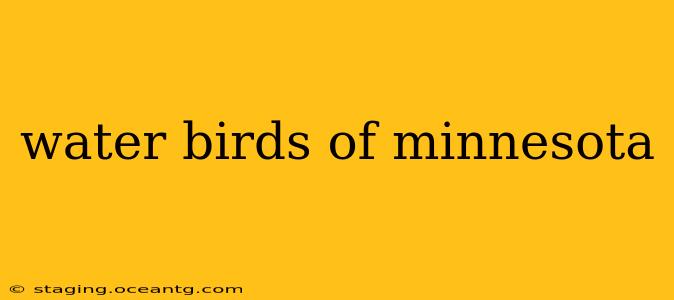Minnesota, with its vast network of lakes, rivers, and wetlands, boasts an incredibly diverse population of water birds. From the majestic loon to the playful grebe, these feathered creatures add vibrancy and beauty to the state's natural landscape. This guide explores the fascinating world of Minnesota's water birds, covering various species, their habitats, and interesting facts.
What are some common water birds found in Minnesota?
Minnesota is a haven for a wide variety of water birds. Some of the most common include:
- Loons: These iconic birds are synonymous with Minnesota's lakes. Common Loons are particularly prevalent, known for their haunting calls and impressive diving abilities. Red-throated Loons are also found, though less frequently.
- Ducks: A plethora of duck species call Minnesota home, including Mallards (ubiquitous and easily recognizable), Wood Ducks (with their striking plumage), Canvasbacks (diving ducks with distinctive white backs), and many more. The specific species present often vary depending on the season and location.
- Grebes: These diving birds, with their sleek bodies and often-puffed-out necks, are a common sight on Minnesota's lakes. Pied-billed Grebes are particularly widespread.
- Gulls and Terns: Various gull and tern species frequent Minnesota's shorelines and larger bodies of water. Ring-billed Gulls are a common sight, alongside others like the Great Black-backed Gull and various tern species.
- Herons and Egrets: These elegant wading birds are often seen stalking prey in shallow waters. Great Blue Herons are a familiar sight, along with Great Egrets and sometimes even rarer species.
- Other Wading Birds: Beyond herons and egrets, Minnesota supports a diversity of wading birds, including various species of sandpipers, rails, and bitterns. These birds often occupy specific habitats within the wetlands.
Where can I find water birds in Minnesota?
Water birds can be found throughout Minnesota's diverse aquatic habitats. Some excellent locations for birdwatching include:
- Large lakes: Lakes such as Mille Lacs, Lake Superior, and the Boundary Waters Canoe Area Wilderness provide habitat for a wide range of species.
- Rivers: The Mississippi River and its tributaries, along with other major rivers, support various water bird populations.
- Wetlands: Minnesota's extensive wetlands, including prairie potholes and marshes, are crucial breeding and feeding grounds for many water bird species. Many state parks and wildlife management areas offer excellent wetland access.
- Coastal areas: Along Lake Superior, you'll find different species adapted to the colder, larger lake environment.
Remember to check local regulations and access points before visiting any specific location.
What is the best time of year to see water birds in Minnesota?
Spring and fall migration periods offer incredible opportunities to see a wide variety of water birds. During these times, many species pass through Minnesota on their journeys north and south. Summer also offers excellent viewing opportunities, as many birds breed and raise their young in Minnesota's waters. Winter, while limiting the number of species present, allows for focused observation of the hardy species that remain, such as Loons and various ducks.
What are some threats to water birds in Minnesota?
Like many bird populations worldwide, Minnesota's water birds face several threats:
- Habitat loss: Drainage of wetlands and development along shorelines reduce critical habitat for breeding, feeding, and resting.
- Pollution: Water pollution from agricultural runoff, industrial discharge, and other sources can harm water birds directly and indirectly through their food sources.
- Climate change: Changing weather patterns and water temperatures can affect breeding success and food availability.
- Predation: While natural predation is part of the ecosystem, human activities can sometimes increase the threat from certain predators.
- Human disturbance: Disturbance from recreational activities near nesting sites can negatively impact breeding success.
How can I help protect Minnesota's water birds?
You can contribute to the conservation of Minnesota's water birds by:
- Supporting wetland conservation efforts: Advocate for policies that protect and restore wetlands.
- Reducing your environmental footprint: Practice responsible waste disposal and reduce your impact on water quality.
- Practicing responsible recreation: Maintain a safe distance from nesting sites and avoid disturbing birds.
- Supporting organizations dedicated to bird conservation: Many organizations work to protect birds and their habitats.
By understanding and appreciating the beauty and importance of Minnesota's water birds, we can all play a role in ensuring their continued survival for generations to come. Remember to always respect their habitat and observe them from a distance to minimize disturbance.
